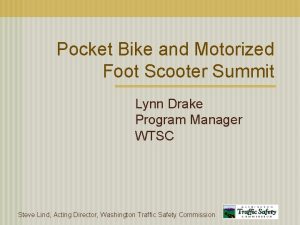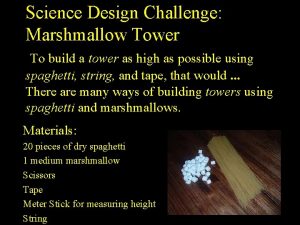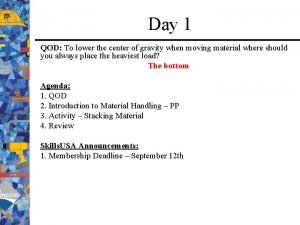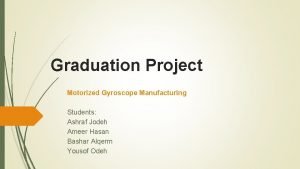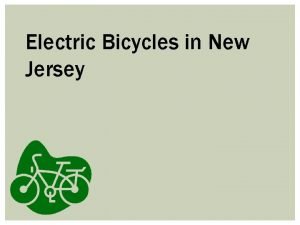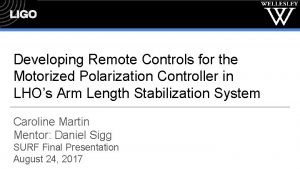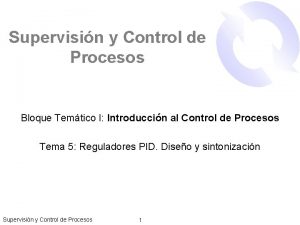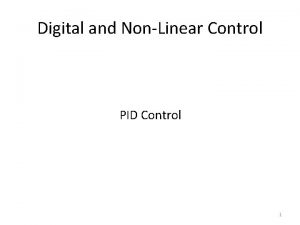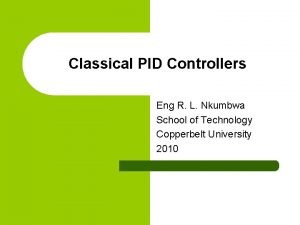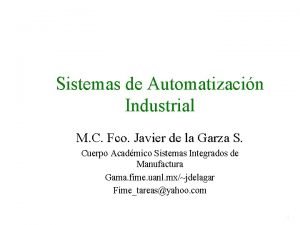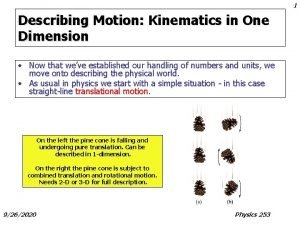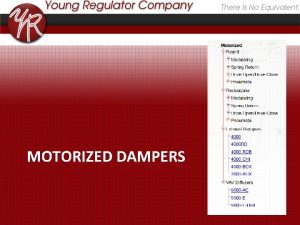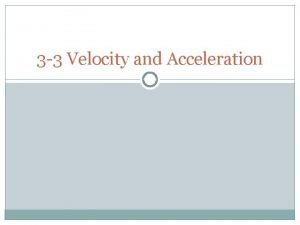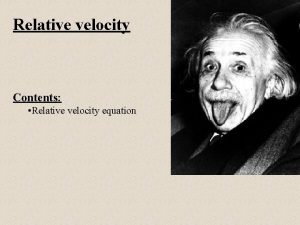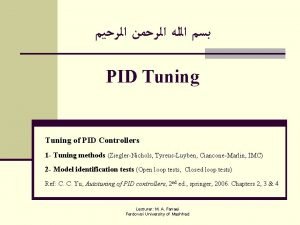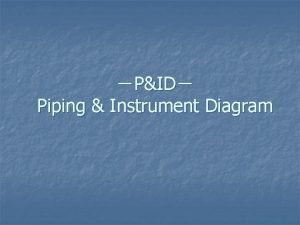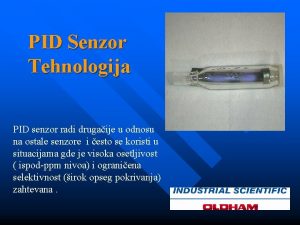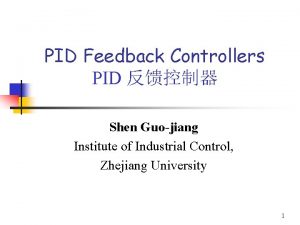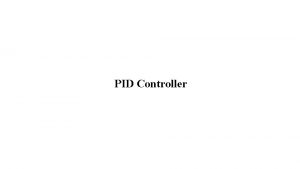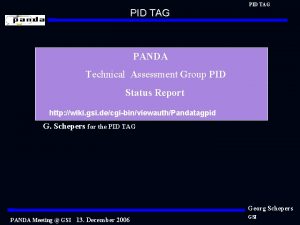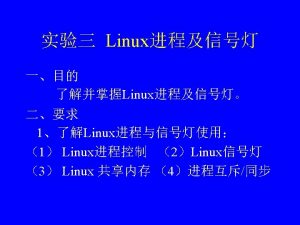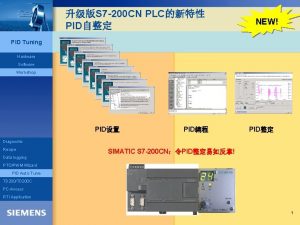PID Case Study Velocity Control of a Motorized






![Power Level [%] Steady-State Speed [RPM] 100 107 85 73 75 55 65 41 Power Level [%] Steady-State Speed [RPM] 100 107 85 73 75 55 65 41](https://slidetodoc.com/presentation_image/2c435b2537dbed6df2c31a2dea44d2bf/image-7.jpg)













- Slides: 20

PID Case Study: Velocity Control of a Motorized Winch-and-Cart Copyright © Paul Oh

Objective: System Identification System ID attempts to capture a plant’s characteristics such as transient response (i. e. rise time) and its stability (steady-state) Typical 2 nd Order Response • Car shock absorbers • Pneumatic pistons • Economic systems Typical 1 st Order Response • DC motors • Damped hydraulics Grandmother Explanation? Copyright © Paul Oh

Lego-Based Motorized Winch-and-Cart Control Goal: Winch load at constant velocity Practical Applications: • Tow truck • Jeep winches • Elevators Winch at constant velocity regardless of load Step 1: Need to characterize open-loop system Recall: motorized winch-and-cart max power occurs for 400 gram mass (0. 12 Nm) For inclined surface, winch speed will be faster. Need step response • NXT commanded at 100% level • Steady state velocity about 107 RPM • 63% of 107 RPM = 67. 4 RPM Copyright © Paul Oh

Steady-state = 107 RPM 63% of steady-state = 67. 4 RPM Rise Time about 0. 06 seconds NB: Want sampling time about 10 to 20 times faster than rise time. Hence sampling time should be about 3 to 6 milliseconds Copyright © Paul Oh

Brick Motor Level input to the cart motor, yields velocity output Consequently have: (1) where is the time constant and is the steady-state gain (to be determined) The Laplace form of (1) yields: (2) The input-output transfer function becomes (3) Also, the solution to the first-order differential equation given in (1) is (4) Copyright © Paul Oh

To calculate the steady-state gain, apply a step input where is a constant At steady-state, with step input, (1) becomes: 0 or k= Yss Steady State Velocity [RPM] = A Step Input Level [Motor %] (5) Step response for Steady-state = 107 RPM Eyeballing, observe that: Yss = 107 RPM 63% of steady-state = 67. 4 RPM Rise Time about 0. 06 seconds Hence: k = Yss 107 RPM = 1. 07 RPM/Level = A 100% Level Copyright © Paul Oh
![Power Level SteadyState Speed RPM 100 107 85 73 75 55 65 41 Power Level [%] Steady-State Speed [RPM] 100 107 85 73 75 55 65 41](https://slidetodoc.com/presentation_image/2c435b2537dbed6df2c31a2dea44d2bf/image-7.jpg)
Power Level [%] Steady-State Speed [RPM] 100 107 85 73 75 55 65 41 50 17 Blah: check this slope calculation… Copyright © Paul Oh

Recall (4) at 63% value is about Y = 67. 4 RPM Steady-state = 107 RPM 63% of steady-state = 67. 4 RPM Hence t = 0. 06 sec Rise Time about 0. 06 seconds Copyright © Paul Oh

Thus from (3) open-loop transfer function due to step input of 100% motor level yields: where t = 0. 06 sec and k = 1. 07. RPM/Level (6) The block diagram representing (6) is simply: F(s) 17. 83 Y(s) [Level] s+16. 7 [RPM] Copyright © Paul Oh

Simulink of (6) 100% motor level (400 g, incline) ~53 RPM 50% motor level (400 g, incline) ~27 RPM 25% motor level (400 g, incline) Copyright © Paul Oh

Note similarity between experimental and simulated plots Copyright © Paul Oh

PID Control (Closed-Loop) of Motorized Winch-and-Cart Goal: Want cart velocity to always be 63 RPM • Even if load changes (within motor limits) • Even if Brick voltage changes (within limits) PID is the most common form of closed-loop control: Why? Copyright © Paul Oh

Answer: One can tune for desired performance without full knowledge of dynamics Without Control (i. e. Open-loop) Copyright © Paul Oh

PID Simulink Simulation May need to multiply desired and set point values to 100/63 Copyright © Paul Oh

However, tuning can be very tedious. Some knowledge of system type aids in tuning, make performance expectations realistic and avoid instability. Analysis: Input-Output Relationship given by: (1) Copyright © Paul Oh

Can reduce to show that (1) becomes: (2) Case Study 1: Proportional only control So (2) becomes: (3) Final Value Theorem states that: Thus steady-state part of (3) becomes: (4) Copyright © Paul Oh

Given that cart velocity has an open-loop transfer function of the following form: (5) Substitution of (5) into (4) yields Applying L’Hopital to calculate the limit yields: Note: If is very large, then Will always have steady-state error Copyright © Paul Oh

Case Study 2: Proportional + Integral control So (2) becomes: Apply Final Value Theorem: (6) Substituting the OLTF (2) into (6) yields: Hence integral action ensures zero steady-state error Copyright © Paul Oh

Systems like the motorized cart are called Type 0 systems: All transfer functions can be factored into the general form: Type 0 System Type 1 System Type 2 System General form any TF A Type i system is the number of “free” integrators, i. The motorized tethered cart, for velocity control, is a Type 0 system For Type 0 Systems: • Will always have steady-state error (with proportional only control): see Case 1 • Integral action will eliminate steady-state error (see Case 2) • Derivative action may increase transient response but cause instability Copyright © Paul Oh

Conclusion: • Open-loop Step Response shows motorized winch-and-cart is a First Order System • Resulting PID closed-loop transfer function yields Type 0 • Type 0 systems just need PI (no derivative) control. Steady-state error will be 0 Copyright © Paul Oh
 Multi loop pid controller regolatore pid multi loop
Multi loop pid controller regolatore pid multi loop Motorized foot scooter
Motorized foot scooter Marshmallow tower challenge
Marshmallow tower challenge Motorized material handling equipment
Motorized material handling equipment Motorized gyroscope
Motorized gyroscope Nj ebike laws
Nj ebike laws Motorized polarization controller
Motorized polarization controller Control procesos
Control procesos Control pid
Control pid Classical pid control
Classical pid control “control de grua” and pid
“control de grua” and pid Best case worst case average case
Best case worst case average case Crm failure case study
Crm failure case study Darcy law example
Darcy law example Linear to angular velocity
Linear to angular velocity Initial velocity and final velocity formula
Initial velocity and final velocity formula Is v final velocity
Is v final velocity Speed unit
Speed unit Instantaneous velocity vs average velocity
Instantaneous velocity vs average velocity Darcy s law
Darcy s law Angular velocity to tangential velocity
Angular velocity to tangential velocity

